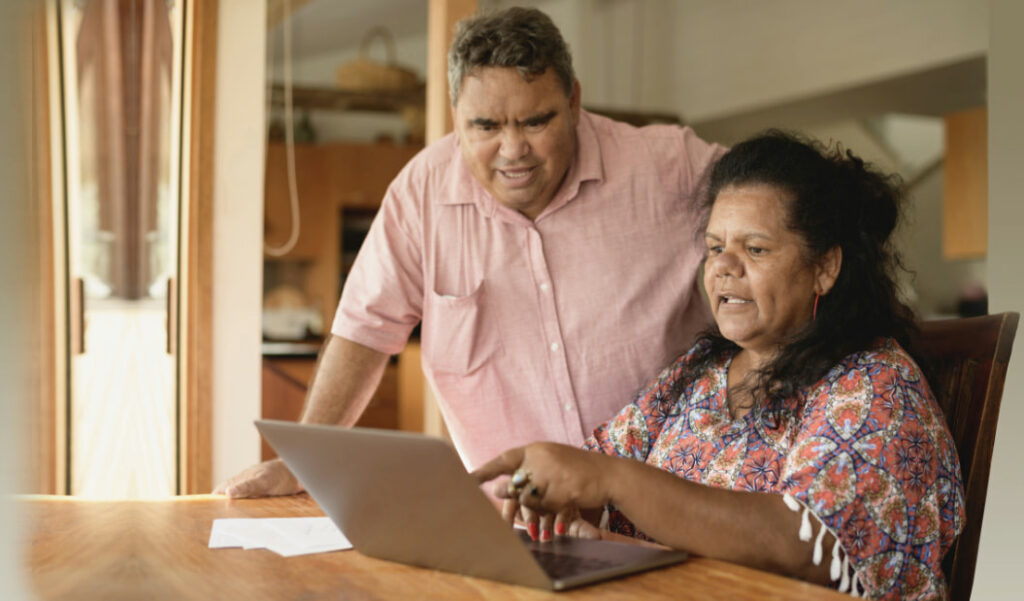
First Nations people with disability are proud of their Aboriginal heritage. They also reported double discrimination because of their disability and culture.
Tim
Tim is 20.
He has autism and intellectual disability. His grandmother was part of the Stolen Generation.
Tim is proud of his Indigenous heritage, but feels he has to constantly prove the bona fides of his identity as well as his disability.
’It’s not just my disability,’ Tim said. ‘It’s also my [Aboriginal] heritage as well I’ve had to prove; so, it’s just been a bumpy ride the whole way through.’
Eileen
Eileen is in her 50s.
She was removed from her family and placed in an institution as an infant. She suffered years of abuse in institutions as well as family violence when she was released.
Eileen was not told she was Aboriginal until she was an adult, after her release into the community. She now lives independently, has connected with her Indigenous community and become a confident self-advocate. She is concerned that people with intellectual disability — particularly people living in group homes — are being manipulated into not speaking out to the Royal Commission.
Eileen said:
‘I reckon people out there with disabilities and intellectual disabilities if they want to have the confidence to tell their story on what happened to them in these institutions. … They should have the right to come and tell you. … They shouldn’t have the staff telling them what they can say and what they can’t say.’
Calum
Calum is 22.
Calum said:
‘Not knowing my rights, I was scared. I didn’t know what to say. … I had to shut up and put up with it. … I got into a lot of fights at high school. I got bullied quite a lot and picked on quite a bit because of my Indigenous side. … That all came out in the end. They were so bottled up inside it was getting to the point where sooner or later it was going to come out of me. And it did … like an earthquake.’
Case Study: Racism and disability
This is the story of an Aboriginal man taken into care as an infant.
Calum is 22. He is Aboriginal.
He was removed from his mother as an infant. His father, who is deceased, was Aboriginal.
He was brought up from infancy by a foster parent he calls ‘Mum’.
When he was 16, Calum was removed from his foster home against the wishes of his Mum and placed in a group home. In the group home, he said he was racially abused for being Aboriginal by a support worker.
‘I didn’t feel safe,’ he said.
‘I was still coming out of the idea of living with my Mum still. I still didn’t understand why they would do that to me and make me go somewhere where I wasn’t comfortable. … I was trapped in this little room and they made me feel like I was useless. They wouldn’t let my friends over; they wouldn’t let me do anything.
‘It felt like I was trapped, that’s what it felt like when I was in the group home. It didn’t feel like anything. It just felt like, “You’re a bad child. You’ve been placed here. We’ll just dump you here.”’
Calum said that the group home had too many rules to keep. At one point, he went to a party and missed his curfew. He said the group home called the police and reported him for absconding. Calum said the police were ‘really nice’ and returned him to the group home, but he felt that the support workers were trying to control his life.
‘I just wanted to be by myself.’
He now lives in a one-bedroom apartment: ’At the moment I’ve got no girlfriend or nobody except for my dog, really. So, it kind of is a bit lonely.’
He is trying to reconnect with his Aboriginal relatives.
These stories were collected and published as part of Inclusion Australia’s submission to the Disability Royal Commission in July 2020.
Blue Knot Foundation runs free counselling for people with disability and their families if this story has raised concerns for you.
Click the links below to download the full story.
